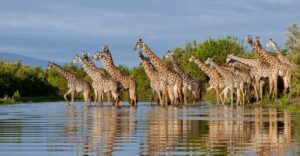Serengeti National Park located northern Tanzania, bordering Kenya with various Serengeti entry gate. The park is renowned for its breathtaking landscape, diverse ecosystem and unique biodiversity. The park is famously known worldwide for its great migration where wildebeest move from place to place looking for green pasture.
To facilitate access to this wonderland of east Africa, various gates were strategically located to facilitate the accessibility of the park by the tourists. Each gate act as a portal where the wildlife can be viewed. The various gates include Seronera gate, Ndabaka gate, Naabi hills gate, Klain’s gate and more. In this article we are looking into each of the gate that makes up the park.
Seronera Gate – Serengeti entry gate
It is located at the centre of Serengeti near River Seronera. Due to the availability of water source, that is river Seronera the animals concentrate there throughout the year giving a perfect sight of wildlife like lion, leopard cheetah throughout the year.
The Gate is also surrounded with a number of lodges which provide convenient accommodation to the visitors
Ndabaka Gate
This is located on the western side of the park on the shores of Grumeti River. The river contains a huge population of crocodiles and hippopotamus. During the famous great migration, the wildebeest and zebras cross this river bringing a predator-prey interaction which result into a breathtaking sight.
The park is limited with accommodation when compared to its counterpart central gate (Seronero Gate).
Naabi Hill Gate – Serengeti entry gate
The gate is located on the southern part of Serengeti National Park. It is an entry from the Ngorongoro conservation area. It provides a breath-taking view of savanna plains and hills
Accommodation is a challenge, but it has a ranger station, toilet and a space for taking photos.
Klein’s Gate
It is situated in the northeastern Serengeti, providing access from the Loliondo Game Controlled Area. The northeastern Serengeti is characterized by vast grasslands and rocky outcrops. It’s an excellent area for spotting elephants, giraffes, dik-diks, and the elusive leopard.
Klein’s Gate offers basic facilities like ranger stations and toilets, but accommodation options are limited in this remote area.
Kirawira Gate – Serengeti entry gate
It is in the western corridor of the park, offering access to the Grumeti River and the Western Corridor. The Western Corridor is known for its diverse wildlife, including large herds of buffalo, elephant, topi, and the occasional wild dog sighting. The Grumeti River provides a critical water source, attracting a variety of animals.
Kirawira Gate provides basic facilities like ranger stations and toilets, but accommodation options are limited compared to the central area.
Lobo Gate
It is Positioned in the northern part of the Serengeti, providing access to remote and less-visited areas of the park. The northern Serengeti offers pristine wilderness and excellent opportunities for off-the-beaten-path safaris. It’s known for its resident wildlife and the dramatic Mara River crossings during the Great Migration.
Lobo Gate offers basic facilities such as ranger stations and toilets. Accommodation options may be limited, but camping is a popular choice for visitors exploring this remote area.
Conclusion – Serengeti entry gate
The Serengeti is not merely a place; it’s an experience that leaves an indelible mark on the soul. Whether witnessing the awe-inspiring spectacle of the Great Migration, encountering the Big Five in their natural habitat, or simply reveling in the boundless beauty of the African savannah, each visit to this extraordinary national park is a testament to the remarkable diversity and resilience of our planet’s natural heritage. Embark on your Serengeti adventure and let the spirit of Africa ignite your senses and stir your soul like never before. Welcome to Serengeti National Park, where every entry gate opens the door to a world of wonder and enchantment.


